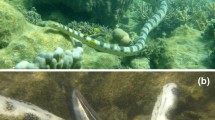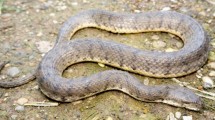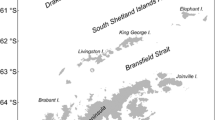Synopsis
For one year, Hoplosternum littorale were sampled monthly from Cano Maraca, a seasonal swamp-creek of the western llanos of Venezuela. H. littorale exhibited a more or less synchronized burst of reproductive activity that coincided with the onset of the rainy season. Spawning was preceded by gradual gonadal recrudescence and a decline in visceral fat deposits during the 5 month dry season. The species is sexually dimorphic with adult males being of larger average size, attaining a larger maximum size, and possessing elongate, recurved pectoral spines and fat deposits on the pectoral fins just prior to and during the spawning season. Aquarium observations revealed that male H. littorale can use the enlarged pectoral spines as weapons during aggressive attacks. This form of aggressive behavior is most likely a component of the brood defense behavior of the species. Both immature and adult H. littorale were microphagous scavengers, taking a variety of food items from the soft mud substrate. Aquatic microcrustacea were the major item in the diet of immature fish. During the late wet and dry seasons, 61% of the stomachs sampled were empty and the intestines air- filled, indicating active use of the gut for aerial respiration.
Similar content being viewed by others

References cited
Atz, J.W. 1957. The relation of the pituitary to reproduction in fishes. pp. 178–270. In: G.E. Pickford & J.W. Atz(ed.) The Physiology of the Pituitary Gland of Fishes, New York Zoological Society, New York.
Carter, G.S. 1935. Respiratory adaptations of the fishes of the forest waters with descriptions of the accessory respiratory organs of Electrophorus electricus and Plecostomus plecostomus. J. Linn. Soc., Zool. 39: 219–233.
Carter, G.S. & L.C. Beadle. 1931. The fauna of the swamps of the Paraguayan Chaco in relation to its environment II. Respiratory adaptations in the fishes. J. Linn. Soc. Lond., Zool. 37: 327–368.
DeSilva, S.S., J. Schut & K. Kortmulder. 1985. Reproductive biology of six Barbus species indigenous to Sri Lanka. Env. Biol. Fish. 12: 201–218.
Greenwood, P.H. 1974. The cichlid fishes of Lake Victoria, East Africa: the biology and evolution of a species flock. Bull. Br. Mus. Nat. Hist., Lond., Zool. Suppl. 6: 1–134.
Hoedeman, J. 1952. Notes on the ichthyology of Surinam (Dutch Guiana). The catfish genera Hoplosternum and Callichthys with a key to the genera and the groups of the family Callichthyidae. Beaufortia, Misc. Pub. Zoo. Mus. Amsterdam 12: 1–12.
Kirschbaum, F. 1975. Environmental factors control the periodical reproduction of tropical electric fish. Experientia 31: 1159–1160.
Kirschbaum, F. 1979. Reproduction of the weakly electric fish Eigenmannia virescens (Rhamphichthyidae, Teleostei) in captivity. I. Control of gonadal recrudescence and regression by environmental factors. Behav. Ecol. Sociobiol. 4: 331–355.
Kirschbaum, F. 1984. Reproduction of weakly electric teleosts: just another example of convergent development? Env. Biol. Fish. 10: 3–14.
Kramer, D.L. 1978. Reproductive seasonality in the fishes of a tropical stream. Ecology 59: 976–985.
Kramer, D.L., C.C. Lindsey, G.E.E. Moodie & E.D. Stevens. 1978. The fishes and the aquatic environment of the central Amazon basin, with particular reference to respiratory patterns. Can. J. Zool. 56: 717–729.
Lowe-McConnell, R.H. 1959. Breeding behavior patterns and ecological differences between Tilapia species and their significance for evolution within the genus Tilapia. Proc. Zool. Soc. Lond. 132: 1–30.
Lowe-McConnell, R.H. 1964. The fishes of the Rupununi savanna district of British Guiana. I. Groupings of fish species and the effects of the seasonal cycles on the fish. J. Linn. Soc., Zool. 45: 103–144.
Lowe-McConnell, R.H. 1975. Fish communities in tropical freshwaters. Longman, London. 337 pp.
Lowe-McConnell, R.H. 1979. Ecological aspects of seasonality in fishes of tropical waters. Symp. Zool. Soc. Lond. 44: 219–241.
Moodie, G.E.E. & M. Power. 1982. The reproductive biology of an armoured catfish, Loricaria uracantha, from Central America. Env. Biol. Fish. 7: 143–148.
Power, M.E. 1984. Habitat quality and the distribution of algaegrazing catfish in a Panamanian stream. J. Anim. Ecol. 53: 357–374.
Roberts, T.R. 1972. Ecology of fishes in the Amazon and Congo basins. Bull. Mus. Comp. Zool. Harv. 143: 117–147.
Schwassman, H.O. 1971. Biological rhythms. pp. 371–428. In: W.S. Hoar & D.J. Randall (ed.) Fish Physiology, Vol. 6, Academic Press, New York.
Schwassman, H.O. 1978. Times of annual spawning and reproductive strategies in Amazonian fishes. pp. 187–200. In: J.E. Thorpe(ed.) Rhythmic Activity of Fishes. Academic Press, London.
Welcomme, R.L. 1969. The biology and ecology of the fishes of a small tropical stream. J. Zool. Lond. 158: 485–529.
Author information
Authors and Affiliations
Rights and permissions
About this article
Cite this article
Winemiller, K.O. Feeding and reproductive biology of the currito, Hoplosternum littorale, in the Venezuelan llanos with comments on the possible function of the enlarged male pectoral spines. Environ Biol Fish 20, 219–227 (1987). https://doi.org/10.1007/BF00004956
Received:
Accepted:
Issue Date:
DOI: https://doi.org/10.1007/BF00004956



